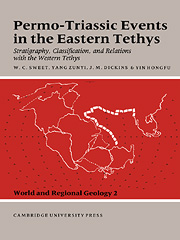 Permo-Triassic Events in the Eastern Tethys
Permo-Triassic Events in the Eastern Tethys Book contents
- Frontmatter
- Contents
- List of contributors
- Preface
- Acknowledgments
- 1 Permo-Triassic events in the eastern Tethys – an overview
- 2 Permo-Triassic boundary relations in South China
- 3 Permo-Triassic boundary of the Indian subcontinent and its intercontinental correlation
- 4 Permo-Triassic boundary on the Indian peninsula
- 5 The Permo-Triassic boundary in the southern and eastern USSR and its international correlation
- 6 Classification and correlation of nonmarine Permo-Triassic boundary in China
- 7 Permian and Triassic events in the continental domains of Mediterranean Europe
- 8 The Permo-Triassic boundary in the Southern Alps (Italy) and in adjacent Periadratic regions
- 9 Permo-Triassic brachiopod successions and events in South China
- 10 Conodont sequences in the Upper Permian and Lower Triassic of South China and the nature of conodont faunal changes at the systemic boundary
- 11 A conodont-based high-resolution biostratigraphy for the Permo-Triassic boundary interval
- 12 The palynofloral succession and palynological events in the Permo-Triassic boundary interval in Israel
- 13 The effects of volcanism on the Permo-Triassic mass extinction in South China
- 14 Geochemical constraints on the Permo-Triassic boundary event in South China
- 15 Permo-Triassic orogenic, paleoclimatic, and eustatic events and their implications for biotic alteration
- 16 Permo-Triassic boundary in Australia and New Zealand
- Index
10 - Conodont sequences in the Upper Permian and Lower Triassic of South China and the nature of conodont faunal changes at the systemic boundary
Published online by Cambridge University Press: 12 October 2009
- Frontmatter
- Contents
- List of contributors
- Preface
- Acknowledgments
- 1 Permo-Triassic events in the eastern Tethys – an overview
- 2 Permo-Triassic boundary relations in South China
- 3 Permo-Triassic boundary of the Indian subcontinent and its intercontinental correlation
- 4 Permo-Triassic boundary on the Indian peninsula
- 5 The Permo-Triassic boundary in the southern and eastern USSR and its international correlation
- 6 Classification and correlation of nonmarine Permo-Triassic boundary in China
- 7 Permian and Triassic events in the continental domains of Mediterranean Europe
- 8 The Permo-Triassic boundary in the Southern Alps (Italy) and in adjacent Periadratic regions
- 9 Permo-Triassic brachiopod successions and events in South China
- 10 Conodont sequences in the Upper Permian and Lower Triassic of South China and the nature of conodont faunal changes at the systemic boundary
- 11 A conodont-based high-resolution biostratigraphy for the Permo-Triassic boundary interval
- 12 The palynofloral succession and palynological events in the Permo-Triassic boundary interval in Israel
- 13 The effects of volcanism on the Permo-Triassic mass extinction in South China
- 14 Geochemical constraints on the Permo-Triassic boundary event in South China
- 15 Permo-Triassic orogenic, paleoclimatic, and eustatic events and their implications for biotic alteration
- 16 Permo-Triassic boundary in Australia and New Zealand
- Index
Summary
Introduction
In the Late Permian, a large-scale regression occurred worldwide and the extent of the sea shrank enormously. As a result, there is a stratigraphic gap between Permian and Triassic rocks in many areas of the world. South China, however, possesses the most widely distributed, fairly continuous marine Permo-Triassic sequences known anywhere in the world. Thus studies of South Chinese Permian and Triassic conodonts are helpful to research on conodont biostratigraphy, biofacies, and Permo-Triassic events and a great deal of work has been done by Wang & Wang (1981, 1983), Wang & Cao (1981), Wang & Dai (1981), Ding (1983), and Yang et al., (1987).
Wang & Wang (1981) divided the Permian and Triassic of South China into 15 conodont zones, four Upper Permian and 11 Lower Triassic, and this scale provides a good basis for future research. Wang & Wang's contributions deal mostly with the determination of stratigraphic age, however, and little attention has been focused on the relationships between conodonts and sediment types or on the nature of the temporal changes in conodont faunas. The purpose of the present study is thus to discuss Permian and Triassic conodont faunas and to demonstrate that the distribution of conodonts in this interval is related to the distribution of sedimentary facies.
Stratigraphy
In South China, marine Permian and Triassic facies occur south of a line joining Lianyun Harbor (Jiangsu Province), Xiang Fan (Hubei Province), and Tianshui (Gansu Province). The area north of this line was continental; hence the Permo-Triassic sections considered in this report are all south of the line, on the Yangtze Platform, which lies east of the ancient Kangdian Land and west of Cathaysia.
- Type
- Chapter
- Information
- Permo-Triassic Events in the Eastern TethysStratigraphy Classification and Relations with the Western Tethys, pp. 109 - 119Publisher: Cambridge University PressPrint publication year: 1992
- 2
- Cited by


